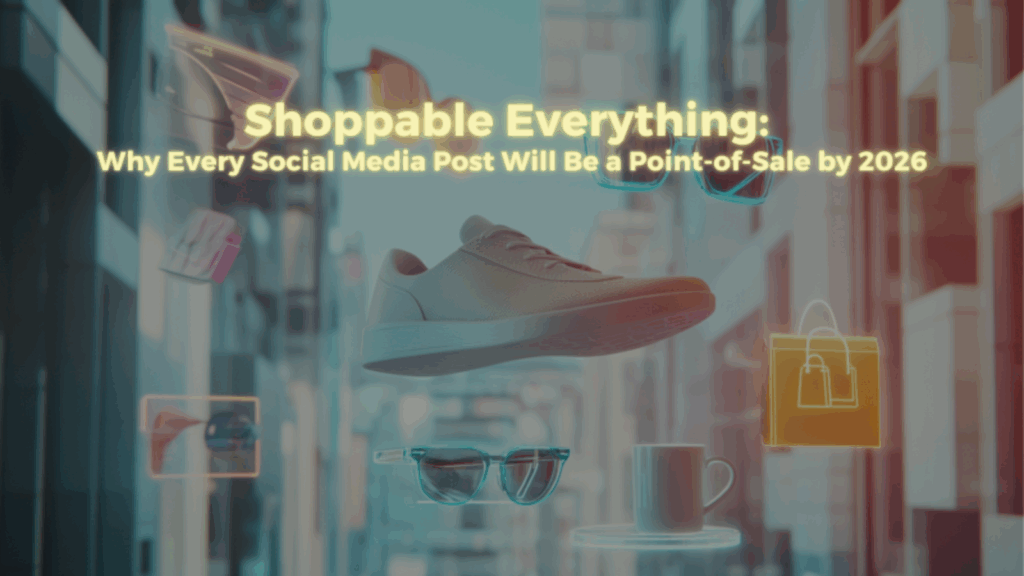
Your Instagram feed just became a shopping mall, and honestly, you probably didn’t even notice it happening. That cute outfit in your friend’s vacation photo? Clickable. The coffee mug in that motivational quote post? Available for immediate purchase. Even that random background plant in a cooking video? Shoppable, with same-day delivery options. We’re living through the most dramatic transformation of commerce since the invention of the credit card, and it’s happening one social media post at a time.
The line between social media content and e-commerce is disappearing so fast that trying to separate them feels like trying to unscramble an egg. Platforms aren’t just adding shopping features anymore. They’re rebuilding their entire infrastructure around the assumption that every piece of content is a potential point-of-sale, every user is a potential customer, and every moment of engagement is a monetization opportunity.
This isn’t some distant future prediction. The shoppable everything revolution is happening right now, generating billions in revenue through purchases that happen without users ever leaving their favorite social media apps. Here’s why every social media post is becoming a store, why traditional e-commerce might become obsolete, and how this changes everything about online shopping forever.
Why Social Commerce Became Inevitable
The transformation from social media to social commerce wasn’t an accident. It was the logical evolution of platforms realizing they were facilitating billions of dollars in purchasing decisions without capturing any of that transaction value. Every time someone discovered a product on Instagram and then went to buy it elsewhere, platforms were essentially providing free marketing for competitors.
Social media platforms also recognized that friction kills conversion. The more steps between product discovery and purchase completion, the more potential customers get lost along the way. By integrating commerce directly into social media experiences, platforms eliminate the friction that traditionally prevented impulse purchases and spontaneous buying decisions.
The COVID pandemic accelerated this transformation by forcing both consumers and businesses to embrace digital-first commerce experiences. Social media became the primary discovery mechanism for new products and brands, making integrated purchasing capabilities essential rather than optional for platform competitiveness.
The Psychology of Impulse Social Shopping
Social commerce succeeds because it leverages psychological triggers that traditional e-commerce can’t replicate. When people see products in the context of content they’re already enjoying, the purchasing decision feels like a natural extension of the entertainment experience rather than a separate commercial transaction.
The social proof element is also incredibly powerful. Seeing friends, influencers, or creators using products provides immediate validation that traditional product descriptions and reviews can’t match. Social context makes purchasing decisions feel safer and more socially acceptable than isolated shopping experiences.
Social media also creates artificial scarcity through temporary content formats like stories and live streams. When users know that shopping opportunities might disappear when content expires, they’re more likely to make immediate purchasing decisions rather than adding items to wish lists for later consideration.
Platform Infrastructure That Makes Everything Shoppable
The technical infrastructure required for seamless social commerce is staggering in its complexity and sophistication. Platforms are building payment processing systems, inventory management tools, shipping integration capabilities, and customer service functions that rival dedicated e-commerce platforms.
Modern social commerce systems can identify products in user-generated content automatically, suggest pricing and purchasing options, and even handle transactions without requiring sellers to manage complex e-commerce setups. The technology makes selling as easy as posting content.
Advanced image recognition and artificial intelligence systems can make virtually any object in any photo or video instantly shoppable by identifying products, finding purchasing sources, and facilitating transactions without human intervention. This automation is what enables the “shoppable everything” vision to become practical reality.
The Creator Economy Integration That Changes Everything
Social commerce transforms creators from content producers into retail partners, providing new monetization opportunities that go far beyond traditional sponsorship and advertising models. Instead of just promoting products, creators become direct sales channels with immediate transaction capabilities.
This integration creates more authentic promotional content because creators can recommend products and facilitate purchases simultaneously. The commercial relationship becomes transparent and immediate rather than hidden behind affiliate links or separate promotional agreements.
Creators also gain access to detailed sales analytics that help them understand which products resonate with their audiences, what pricing strategies work best, and how to optimize their content for commercial success while maintaining audience engagement.
The Shopping Experience That Feels Like Entertainment
The most successful social commerce experiences blur the line between entertainment and shopping so effectively that users enjoy the purchasing process as much as the content consumption. Shopping becomes part of the social media experience rather than interrupting it.
Live shopping streams combine entertainment, education, and commerce into single experiences where viewers can ask questions, see product demonstrations, and make purchases while interacting with hosts and other viewers. These experiences create community around commerce in ways that traditional shopping can’t replicate.
Interactive product demonstrations, virtual try-on experiences, and augmented reality shopping tools make social commerce more engaging and informative than traditional e-commerce while maintaining the social elements that make the experience enjoyable rather than transactional.
The Data Revolution That Powers Personalized Commerce
Social commerce generates unprecedented amounts of data about consumer behavior, preferences, and purchasing patterns because it combines social interaction data with commercial transaction information. This integrated data provides insights that traditional e-commerce and social media analytics can’t match.
Platforms can analyze not just what people buy, but what content influenced their purchasing decisions, which social proof elements were most persuasive, and how social interactions affected commercial outcomes. This data enables increasingly sophisticated personalization and recommendation systems.
The behavioral data from social commerce also helps predict purchasing intent more accurately than traditional e-commerce signals, allowing platforms to present relevant shopping opportunities at optimal moments rather than relying on generic advertising approaches.
Business Model Transformations That Reshape Industries
Social commerce is forcing traditional retailers to completely rethink their customer acquisition and engagement strategies. Instead of investing in separate social media marketing and e-commerce platforms, businesses need integrated approaches that treat social media as their primary sales channel.
Small businesses and individual entrepreneurs gain access to sophisticated commerce capabilities that were previously available only to large retailers with substantial technology investments. Social commerce democratizes advanced retail technology while providing built-in audience development tools.
Traditional e-commerce platforms are being forced to add social features and community building tools to compete with social media platforms that offer integrated commerce capabilities. The competition is driving innovation in both social media and e-commerce technology.
The Global Marketplace That Lives in Your Feed
Social commerce creates global marketplaces within social media platforms where users can discover and purchase products from anywhere in the world without leaving their favorite apps. This global reach provides opportunities for small businesses to access international markets without complex export logistics.
Currency conversion, international shipping, and local payment method integration are being handled automatically by platform infrastructure, making cross-border commerce as simple as domestic purchases for both buyers and sellers.
The global nature of social commerce also exposes users to products and brands they would never encounter through traditional shopping methods, expanding consumer choice while creating opportunities for businesses to reach previously inaccessible markets.
Privacy and Security Implications of Integrated Commerce
The integration of commerce into social media platforms raises significant privacy and security concerns because platforms now handle both personal social data and sensitive financial information. The security requirements for social commerce exceed those of traditional social media or e-commerce alone.
Data protection becomes more complex when social interaction information is combined with purchasing history, payment details, and shipping addresses. Users need to trust platforms with increasingly comprehensive personal information to enable seamless commerce experiences.
Regulatory compliance also becomes more challenging as social commerce platforms must satisfy both social media regulations and financial services requirements across multiple jurisdictions while maintaining user-friendly experiences.
The Traditional Retail Disruption That’s Already Happening
Physical retail stores are being forced to develop social media strategies that go far beyond traditional marketing to include direct sales capabilities, influencer partnerships, and community building initiatives that compete with social commerce platforms.
Traditional e-commerce websites are losing traffic and conversion rates to social commerce platforms that provide more engaging discovery experiences and simpler purchasing processes. The shift represents a fundamental change in how consumers prefer to shop online.
Shopping malls and retail centers are experimenting with social media integration, live streaming capabilities, and creator partnership programs to remain relevant in an increasingly social commerce-dominated marketplace.
The Future of Purchase Decision Making
Social commerce is changing how consumers discover products, evaluate options, and make purchasing decisions by integrating commerce into social discovery rather than requiring separate shopping sessions. This integration makes purchasing decisions more spontaneous and socially influenced.
The social context of purchasing decisions also changes how consumers think about product value, brand loyalty, and shopping experiences. Social proof and community recommendations become more influential than traditional marketing messages or product specifications.
Future purchasing behavior will likely be increasingly influenced by social media content, creator recommendations, and peer purchasing patterns rather than traditional advertising or promotional campaigns.
Preparing for the Shoppable Everything Economy
Businesses that want to succeed in the shoppable everything economy need to develop content strategies that seamlessly integrate product promotion with valuable, entertaining content that audiences want to engage with regardless of commercial intent.
Investment in creator partnerships, social media content production, and platform-specific commerce capabilities will become essential for maintaining competitive advantage as social commerce becomes the dominant online shopping method.
Traditional marketing approaches that separate content marketing from sales processes will become increasingly ineffective as audiences expect integrated experiences that combine entertainment, education, and commerce opportunities.
The Timeline That’s Moving Faster Than Expected
The transition to shoppable everything is happening faster than most industry predictions anticipated. Platform investments in commerce infrastructure, consumer adoption of social shopping behaviors, and business adaptation to social commerce models are all accelerating beyond original projections.
Major social media platforms are prioritizing commerce feature development over traditional engagement tools, indicating that social commerce has become central to their business strategies rather than supplementary revenue streams.
Consumer behavior changes suggest that social commerce adoption will reach critical mass well before traditional timelines predicted, making immediate adaptation essential for businesses that want to maintain market relevance.
The shoppable everything revolution isn’t coming. It’s here, transforming how we discover, evaluate, and purchase products through social media experiences that feel natural rather than commercial. The businesses that adapt quickly will capture enormous opportunities in this new commerce landscape.
The question isn’t whether every social media post will become a point-of-sale. The question is whether your business will develop social commerce capabilities quickly enough to compete effectively in a marketplace where content and commerce have become inseparable.
Ready to turn your social media presence into a sales engine? The platforms, tools, and audience are already there. The shoppable everything economy is waiting for businesses smart enough to embrace commerce as entertainment, shopping as social experience, and sales as community building.


